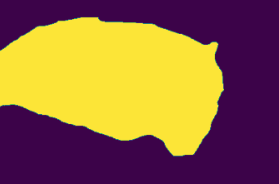Introduction to image segmentation
Deep Learning for Images with PyTorch

Michal Oleszak
Machine Learning Engineer
Image segmentation
- Image segmentation partitions the image into multiple segments on the pixel level
- Each pixel in an image is assigned to a particular segment
- Three types of segmentation:
- Semantic segmentation
- Instance segmentation
- Panoptic segmentation
Semantic segmentation

- Each pixel classified into a class
- All pixels belonging to the same class are treated equally
Instance segmentation

- Distinguishes between different instances of the same class
- Background often not segmented
Panoptic segmentation

- Combines semantic and instance segmentations
- Assigns a unique label to each instance of an object
- Classifies background at pixel level
Data annotations
image = Image.open("images/British_Shorthair_36.jpg") mask = Image.open("annots/British_Shorthair_36.png")transform = transforms.Compose([ transforms.ToTensor() ]) image_tensor = transform(image) mask_tensor = transform(mask)print(f"""Image shape: {image_tensor.shape} Mask shape: {mask_tensor.shape}""")
Image shape: torch.Size([3, 333, 500])
Mask shape: torch.Size([1, 333, 500])

Understanding the mask
Dataset documentation:
Pixel Annotations: 1: Foreground 2: Background 3: Not classified
Unique mask values:
mask_tensor.unique()tensor([0.0039, 0.0078, 0.0118])Pixel values are divided by
255:1 / 255 = 0.0039- object2 / 255 = 0.0.0078- background3 / 255 = 0.0118- unclassified
Creating a binary mask
binary_mask = torch.where( mask_tensor == 1/255, torch.tensor(1.0), torch.tensor(0.0), )to_pil_image = transforms.ToPILImage() mask = to_pil_image(binary_mask)plt.imshow(mask)

torch.where():- Condition
- Value to use if condition met
- Value to use otherwise
- Transform mask to PIL image
- Display mask image
Segmenting the object
object_tensor = image_tensor * binary_maskto_pil_image = transforms.ToPILImage() object_image = to_pil_image(object_tensor)plt.imshow(object_image)

- Multiply image with the binary mask
- Transform object to PIL image
- Display object image
Let's practice!
Deep Learning for Images with PyTorch

